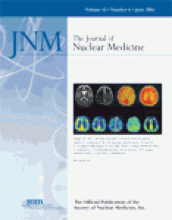M.J. Welch and C.S. Redvanly, eds New York, NY: J. Wiley, 2003, 848 pages, $240
This book evaluates emerging biologic technologies and their potential to redirect early diagnosis and therapy of diseases. Unlike anatomically based imaging methods such as CT alone and MRI, PET and SPECT are unique forms of CT that produce images of biochemical and physiologic processes in tissues. Use of PET and SPECT radiotracers can monitor the effectiveness or ineffectiveness of therapies. With a quantitative biochemical imaging tool, the oncologist can maximize the therapeutic regimen by quantifying and predicting a tumor-specific biologic response to a chemotherapeutic agent in each patient. For instance, intracellular steroid receptors (estrogen and progesterone receptors) are detected in 30%–71% of specimens from patients with epithelial ovarian cancer. Thus, estrogen or progesterone receptor–labeled agents would be an extremely valuable tool in the cost-effective management of ovarian cancer. In chapter 25 (pages 722–733), synthetic techniques of labeling steroids are described. In addition, quantitative PET or SPECT imaging may allow the rapid development of new chemotherapeutic drugs.
This book describes the mechanism-directed antibodies (chapter 24) for radiodiagnostic and internal radionuclide therapy (131I, 90Y) applications. Organ-specific agents are described (heart, chapter 18; lung, chapter 26; and liver and kidney, chapter 28). In tumor imaging and treatment response follow-up, this book focuses on several areas. One of these is cell cycle control (11C and 18F-thymidine, chapter 22). Research of the relationship between intracellular signal transduction, cell cycles, and cell growth is likely to detect specific mechanisms to induce normal cell cycling and apoptosis in tumor cells without damaging normal cells. Assessment of cell cycle would indicate effectiveness in cancer therapeutics. Another focus of the book is the gene- and nucleic acid–based approach (chapter 15). Gene-based cancer diagnostics offer the potential of predisposition testing, early diagnosis, and a more accurate prognosis. A third focus is immunologic approaches. The early detection of tumor antigens remains a competitive market. Labeling techniques and isotope selection are described. A fourth focus is the antiangiogenesis approach. Antiangiogenesis is a strategy for starving tumors by interrupting their blood supply. Radiolabeled antiangiogenesis integrins and the RGD (-Arg-Gly-Asp-) sequence (page 671) are described. A fifth focus is the tumor hypoxia approach. Tumor hypoxia markers remain an important issue in tumor cell radioresistance. Nitroimidazole analogues are described. A final focus is the receptor-targeting approach (chapter 25). Endogenous hormones such as estrogens, progestins, and androgens develop a high level of receptors in the cancerous stage. Thus, radiolabeled estrogen, progestin, and androgen could provide early diagnosis and treatment follow-up of hormone-related tumors.
This book describes clinically useful isotopes for radiodiagnostic (PET and SPECT) and radiotherapeutic applications. For instance, 68Ga is a positron-emitting isotope with a half-life of 68 min and a high abundance of positrons (89%), making it ideal for PET imaging. The half-life allows chemical manipulation but limits the dose received by the patient. Unlike many of the other isotopes used for PET that are cyclotron produced, 68Ga is obtained from a 68Ge/68Ga generator. 68Ge (half-life = 280 d) is loaded onto a tin dioxide column, which decays by electron capture to 68Ga. The generator can be eluted several times a day with 1N HCl, producing 68Ga in a form suitable for rapid synthesis of radiopharmaceuticals. The long half-life of the 68Ge parent (280 d) allows for a shelf-life of 1.5–2 y for the generator. This generator system enables hospitals that cannot afford a cyclotron to perform PET imaging. 188Re has good characteristics for imaging and for therapeutic use, because of its β-energy (2.1 MeV), its short physical half-life (16.9 h), and its 155-keV γ-ray emission for dosimetric and imaging purposes. The short physical half-life of 188Re allows for higher doses than are possible with longer-lived radionuclides. Furthermore, the short half-life reduces the problems of handling and storing radioactive waste. In particular, 188Re is convenient for clinical use because it can be obtained from a 188W/188Re generator. Cyclotron-produced copper isotopes are also useful for radiodiagnostics (60Cu, 61Cu, 64Cu) and radiotherapeutics (67Cu) (chapter 12). The chemistry described was either through chelators (chapters 11 and 12) or through covalent reactions (chapters 5, 6, and 14). PET synthesis needs to be fast because of the short half-life of the isotope used, and the book describes automated synthesis of PET radiopharmaceuticals (chapter 8). The information provided in this book is useful in drug design and radiochemistry synthesis.







